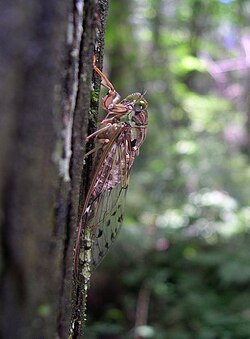| Tanna | |
|---|---|
 | |
| Tanna japonensis (Female) | |
| Scientific classification | |
| Kingdom: | Animalia |
| Phylum: | Arthropoda |
| Class: | Insecta |
| Order: | Hemiptera |
| Suborder: | Auchenorrhyncha |
| Family: | Cicadidae |
| Subfamily: | Cicadinae |
| Tribe: | Leptopsaltriini |
| Genus: | Tanna Distant, 1905 |
| Synonyms [1] | |
| |
Tanna is a genus of cicadas from Southeast Asia and East Asia. [2] [3] In 2010 Lee and Hill placed Tanna in the subtribe Leptopsaltriina, which is now in the tribe Leptopsaltriini together with a number of related genera that also possess abdominal tubercles, including Aetanna , Leptopsaltria , Maua , Nabalua , Purana , and others. [4]